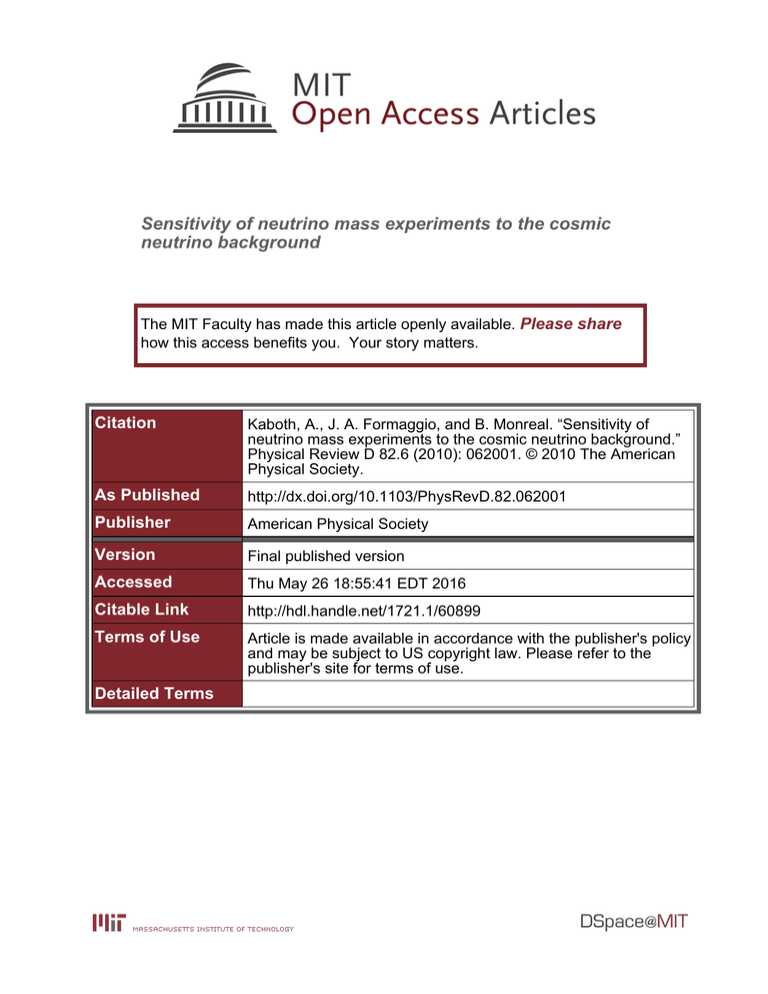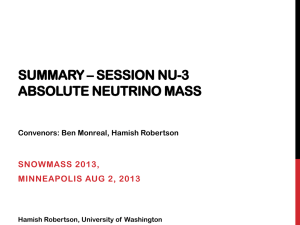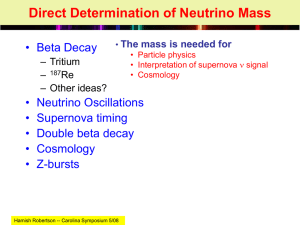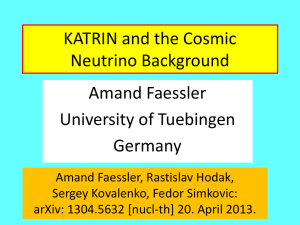Sensitivity of neutrino mass experiments to the cosmic neutrino background Please share
advertisement

Sensitivity of neutrino mass experiments to the cosmic neutrino background The MIT Faculty has made this article openly available. Please share how this access benefits you. Your story matters. Citation Kaboth, A., J. A. Formaggio, and B. Monreal. “Sensitivity of neutrino mass experiments to the cosmic neutrino background.” Physical Review D 82.6 (2010): 062001. © 2010 The American Physical Society. As Published http://dx.doi.org/10.1103/PhysRevD.82.062001 Publisher American Physical Society Version Final published version Accessed Thu May 26 18:55:41 EDT 2016 Citable Link http://hdl.handle.net/1721.1/60899 Terms of Use Article is made available in accordance with the publisher's policy and may be subject to US copyright law. Please refer to the publisher's site for terms of use. Detailed Terms PHYSICAL REVIEW D 82, 062001 (2010) Sensitivity of neutrino mass experiments to the cosmic neutrino background A. Kaboth and J. A. Formaggio Laboratory for Nuclear Science, Massachusetts Institute of Technology, Cambridge, Massachusetts, USA B. Monreal Department of Physics, University of California, Santa Barbara, Santa Barbara, California, USA (Received 21 June 2010; published 13 September 2010) The KATRIN neutrino experiment is a next-generation tritium beta decay experiment aimed at measuring the mass of the electron neutrino to better than 200 meV at 90% C.L. Because of its intense tritium source, KATRIN can also serve as a possible target for the process of neutrino capture, e þ 3 H ! 3 Heþ þ e . The latter process, possessing no energy threshold, is sensitive to the cosmic neutrino background (CB). In this paper, we explore the potential sensitivity of the KATRIN experiment to the relic neutrino density. The KATRIN experiment is sensitive to a CB overdensity ratio of 2:0 109 over standard concordance model predictions (at 90% C.L.), addressing the validity of certain speculative cosmological models. DOI: 10.1103/PhysRevD.82.062001 PACS numbers: 23.40.Bw, 14.60.Pq, 98.80.Es, 98.80.k I. INTRODUCTION The observation of the cosmic microwave background (CMB) stands as one of the most significant scientific discoveries of the 20th century [1,2]. The series of measurements made after its initial observation—ever increasing in precision and scope—has helped transform observational cosmology into an extremely predictive science [3]. One need only to look at the recent discoveries of dark matter and dark energy to appreciate this progression [4,5]. Many of the parameters of the cosmological concordance model have now been measured and further exploration of these parameters over the next few decades is likely to reveal even more hidden aspects of our Universe. Though many of the predictions from cosmology have now been realized, there are others that remain unobserved. Among these is the observation of the cosmic neutrino background (CB) produced from the primordial big bang. Like their photon counterparts, their existence in the cosmos is expected; yet, direct observation of CB remains elusive. Observation of the cosmic relic neutrinos—or, conversely, the absence of such—stands as an important verification of the theory. Direct observation of relic neutrinos is an extremely difficult challenge from an experimental perspective. The neutrino temperature T is related directly to the CMB temperature, T , such that T ¼ ð4=11Þ1=3 T , or 1:9 K [6]. The average CB neutrino kinetic energy, assuming a simple Fermi-Dirac distribution, is expected to be less than 0.2 meV. Most conventional methods of detecting neutrinos, such as water Cerenkov or scintillator detectors, rely on interactions that have some threshold for the energy of the incoming neutrino, which is often many orders of magnitude larger than the CB energies. Fortunately, there does exist a promising candidate by which such low energy 1550-7998= 2010=82(6)=062001(6) neutrinos can be detected: neutrino capture on radioactive nuclei. The process was originally proposed by Weinberg [7] but has been recently revisited by others [8–10]. The generic process, e þ N ! N 0 þ e , is energetically allowed when m þ mN > mN0 þ me . Conveniently, this is also the required energetics at very small neutrino mass for the more familiar process of beta decay. The signal of this neutrino capture process is distinctive: the electrons create a monoenergetic peak at E ¼ E0 þ m , where E is the kinetic energy of the detected electron, E0 is the endpoint energy of the beta decay process assuming zero neutrino mass, and m is the mass of the electron neutrino. For a detector with sufficient resolution, it is in principle possible to separate this monoenergetic peak from the tail distribution of the beta decay spectrum. Recent and upcoming experiments that make use of beta decay nuclei have made significant advances in both source strength and energy resolution in order to probe the scale of neutrino masses. It is natural to inquire, therefore, what sensitivity can reasonably be expected on the CB from these experiments given their experimental and physical limitations. In this paper, we explore the potential sensitivity of tritium beta decay experiments, like the Karlsruhe Tritium Neutrino Experiment (KATRIN), to cosmic relic neutrinos [11]. II. DETECTION OF THE CB The total CB rate depends on the cross section of capture on tritium and the local CB density, N M Z d3 p R ¼ n A eff v fðp Þ ; (1) A 23 where NA is Avogadro’s number, A is the target atomic number, n is the relic neutrino density, Meff is the effective target mass, is the CB cross section, v and p are 062001-1 Ó 2010 The American Physical Society A. KABOTH, J. A. FORMAGGIO, AND B. MONREAL PHYSICAL REVIEW D 82, 062001 (2010) TABLE I. The event rates for three different neutrino masses and three different mass profiles for the CB. Rates are calculated by scaling the results of Ref. [8] by the tritium mass of the KATRIN experiment. All rates are given in events/yr. m Fermi-Dirac Event Rates (events/yr) Navarro, Frenk, and White Milky Way 0.6 0.3 0.15 5 106 5 106 5 106 6:0 105 1:5 105 6:7 106 1:0 104 2:2 105 8:0 106 the neutrino velocity and momenta, respectively, and fðp Þ is the momentum distribution of the relic neutrinos, which we treat as a simple Fermi-Dirac distribution of characteristic temperature T . The expected cross section for relic neutrinos on tritium in the limit of zero momentum yields vc of ð7:84 0:03Þ 1045 cm2 [8]. The relatively high cross section places tritium as a preferred target for the sought reaction. The other commonly used beta decay isotope, 187 Re, is employed by the MARE experiment [12] and is valued for its low end-point energy. However, the cross section for neutrino capture on 187 Re is almost 7 orders of magnitude lower than that of tritium. Other practical considerations, such as availability, the low energy of the end point, and final state effects make tritium favorable in comparison to other potential target materials. The detected neutrino capture reaction also depends on the local neutrino density. A local enhancement of the neutrino density—over the standard 55 neutrinos=cm3 per flavor—can occur if the neutrino mass is large enough to allow clumping within the Milky Way. The amount of neutrino overdensity will in general depend on both the neutrino mass and the matter density profile of our Galaxy. Table I shows the expected CB capture rate given KATRIN’s tritium target mass under a number of density scenarios: (a) a standard homogenous Fermi-Dirac distribution; (b) a Navarro, Frenk, and White [13] dark matter halo profile; and (c) for a mass distribution of the Milky Way (MW), using the local neutrino densities computed in [14]. Clearly, the expected rates shown here are well below the detection threshold. However, understanding the analysis and limits at the KATRIN experiment provides a critical first step in understanding how to build and develop future CB experiments. III. THE KATRIN NEUTRINO MASS EXPERIMENT The Karlsruhe Tritium Neutrino Experiment is the nextgeneration tritium beta decay experiment with sub-eV sensitivity to make a direct, model independent measurement of the electron neutrino mass. The principle of the experiment is to look for a distortion at the high energy end point of the electron spectrum of tritium decay: 3H ! 3 Heþ þ e þ e : The shape of the electron energy spectrum of tritium beta decay is determined by well-understood or measurable quantities. Any deviation from this shape would be directly attributable to neutrino mass and would allow a direct determination of the mass of the electron neutrino. After three years of running, KATRIN will be able to achieve a sensitivity of mðÞ < 200 meV (at 90% C.L.). This level represents an order of magnitude improvement on the absolute neutrino mass scale. Since the measurement of electrons extends beyond the end point of the decay, in order to monitor background, it is also possible to look for the CB signature. The experiment is located at the Forschungszentrum Karlsruhe (FZK). The FZK is a unique location as it hosts the Tritium Laboratory Karlsruhe, which is in charge of the tritium cycle of the international ITER fusion program. It thus offers the expertise needed to handle large quantities of tritium. KATRIN will use the windowless gaseous tritium source technique, as used by Los Alamos [15] and Troitsk [16]. Decay electrons from the source pass through a 10-meter long differential and cryogenic pumping subsection guided by superconducting magnets. The purpose of the differential pumping system is to prevent gas from entering the spectrometer system, which would degrade resolution and raise background by contaminating the system with tritium. The KATRIN experiment is based on technology developed by the Mainz [17] and Troitsk [16] tritium beta decay experiments. These experiments used a so-called MAC-E-filter (magnetic adiabatic collimation combined with an electrostatic filter). This technology draws the isotropic electrons from a decay or capture event along magnetic field lines through a decreasing magnetic field so that the cyclotron motion of the electrons around the magnetic field lines is transformed into longitudinal motion along the magnetic field lines. A retarding potential is applied such that only electrons with energy greater than the retarding potential are transmitted to an electron counting detector. By varying the retarding potential, the shape of the decay spectrum can be reconstructed. The energy resolution of this measurement is determined by the BA 1 ratio E E ¼ Bmax ¼ 20 000 , where BA is the magnetic field in the analyzing plane (the point of maximum potential) and Bmax is the maximum magnetic field. The decay electrons exiting the spectrometer are imaged onto a silicon diode array using a 6 T superconducting magnet. The electrons counted in the detector array comprise the signal needed to reconstruct the beta decay spectrum. The most critical aspect of the KATRIN experiment relevant for the detection of the CB is the number of tritium atoms available for neutrino capture and electron detection. This is given by (2) 062001-2 Neff ¼ NðT2 Þ P; 2 SENSITIVITY OF NEUTRINO MASS EXPERIMENTS TO . . . PHYSICAL REVIEW D 82, 062001 (2010) 2 where NðT2 Þ is the number of tritium molecules, is the solid angle of the source as seen by the detector, and P is the probability that the emitted electron exits the source without undergoing an inelastic scattering process. The number of tritium molecules in the source is given by where d is the source column density, T ¼ 0:95 is the tritium purity, and As ¼ 52:65 cm2 is the source area. Thus the signal rate can be written as Neff ¼ As T P d: 2 The factor P d can be considered as an effective column density, deff , which has the value 3:58 1017 =cm2 at KATRIN [11]. The effective tritium source strength is equivalent to Neff ¼ 6:64 1018 tritium molecules, or an equivalent mass of Meff ¼ 66:5 g. Because the KATRIN experiment measures the integral beta decay spectrum above some threshold qU, the electron spectrum is really the convolution of the and CB electron spectrum, dN=dE, and the transmission function of the detector, TðE; qUÞ. KATRIN also expects a small but finite background rate, Nb , to contribute to the overall signal. Currently, this background rate is expected to be of order 10 mHz in the signal region of interest, independent of retarding voltage, Z 1 dN GðqUÞ ¼ TðE; qUÞdE þ Nb : (3) qU dE The tritium beta decay energy spectrum has an analytic form [18] given by Eq. (4) X dN ¼ ðNT2 FðZ; EÞpe ðE þ me ÞðE0 EÞ dE fs qffiffiffiffiffiffiffiffiffiffiffiffiffiffiffiffiffiffiffiffiffiffiffiffiffiffiffiffiffiffiffiffiffiffi ðE0 EÞ2 m2 ðE0 EðfsÞ m Þ 2 2 þ NCB eðððE0 EðfsÞþm Þ Þ=2 Þ ÞPðfsÞ; (4) where FðZ; EÞ is the Fermi function for beta decay, E0 is the end-point energy of the 3 H2 ! ð3 He3 HÞþ þ e þ e decay, E is the kinetic energy of the emitted electron, and NT2 and NCB are the rates of tritium beta decay and neutrino capture, respectively. The Gaussian term represents the capture signal from the CB centered at one neutrino mass above the end point, with a width chosen to be smaller than any characteristic resolution present in the experiment, but sufficiently large to be reliably integrable by numerical methods. Because the target involves the presence of molecular T2 gas, one must include any corrections to the end-point energy due to the molecular daughter molecule following the tritium decay. An accounting of these states is given in [19]. Of most relevance are the effects of the rotational-vibrational contributions from decays to the ground state, which introduce 106 CνB events/yr 0 CνB events/yr Event Rate (Hz) NðT2 Þ ¼ d T As ; 10 1 10-1 10-2 18555 18560 18565 18570 18575 18580 Retarding Potential (V) FIG. 1 (color online). The anticipated beta decay spectrum as a function of retarding voltage with (black) and without (red) neutrino capture events. Neutrino mass is assumed to be 1 eV. a mean excitation energy of 1.7 eV with an inherent broadening of 0.36 eV. In this analysis, the final states are taken into account via a summation over the states fs of the Heþ T molecule, each final state weighted by the probability PðfsÞ for that state occurring. The transmission function, TðE; qUÞ, depends on the value of the retarding potential, qU, as well as the intrinsic resolution of the main spectrometer. For an isotropic source, TðE; qUÞ can be written analytically as 8 > > 0 qffiffiffiffiffiffiffiffiffiffiffiffiffiffiffiffiffi if E qU < 0 > > > > S < 1 1ðEqUÞB EBA qffiffiffiffiffiffiffiffiffiffiffiffiffi if 0 E qU E ; (5) TðE; qUÞ ¼ > EBS > 1 1EBmax > > > > :1 if E qU > E where E is the electron energy, BS is the magnetic field at the source, BA is the magnetic field at qU, Bmax is the 1 maximum (pinch) field, and E E ¼ 20 000 at KATRIN. A sample decay spectrum, with and without neutrino capture, is shown in Fig. 1. IV. SIGNAL EXTRACTION AND RESULTS To calculate the sensitivity, the data sets were fit over six parameters: the neutrino mass (m ), the CB rate (NCB ), the end point of the beta decay spectrum (E0 ), the beta decay rate (NT2 ), the width of the CB peak (), and the background rate (Nb Þ. We assume the same projected KATRIN run measurement plan as reported in [11]. The results of the fit in the mass and capture rate are plotted 062001-3 A. KABOTH, J. A. FORMAGGIO, AND B. MONREAL PHYSICAL REVIEW D 82, 062001 (2010) 20000 CνB (events/year) CνB (events/year) 10000 10000 0 -10000 0 -10000 -20000 -20000 -0.2 0 0.2 0.2 0.25 mν (eV) 0.3 0.35 mν (eV) 20000 10000 CνB (events/year) CνB (events/year) 20000 0 -10000 -20000 10000 0 -10000 -20000 0.55 0.6 0.65 0.95 mν (eV) 1 1.05 mν (eV) FIG. 2 (color online). Confidence regions for cosmic neutrino captures in events per year versus neutrino mass in eV for four example neutrino masses. Statistical errors only are shown. The red ellipse shows 90% C.L. in the CB events per year and neutrino mass parameter space. for 2000 simulated experiments to create the confidence regions shown in Fig. 2. The figure shows only statistical errors; the systematic errors are estimated for four of the major errors for KATRIN: high voltage precisions, magnetic field precision, the effect of final states, and the error on the number of available tritium atoms. The errors are estimated by shifting the Monte Carlo data sets by 1 standard deviation on the error and fitting at the central value of that parameter. The relative contributions to the errors for the mass and CB rate are shown in Table II. The 90% limit is shown for a variety of masses in Fig. 3. Shown on the right-hand side of the plot is the limit on the local density of neutrinos at Earth. There is a slight decrease in sensitivity near 2 eV due in part because the run plan for KATRIN is discretized and optimized for a neutrino mass search. The discretization in the retarding potential in 0.5 V steps in the region of interest means that the CB search is TABLE II. Error contributions to the CB for four major KATRIN systematics at m ¼ 0 eV. Errors are extended to other masses as a percentage of statistical errors. Note that the error on the final states is limited by Monte Carlo statistics. Contributor High voltage Magnetic field Final states Normalization Statistical Total 062001-4 Error (events/yr) 5850 2020 1420 2080 8340 10 680 Percentage of statistical errors 70.1% 24.2% 17.0% 24.9% – 128% SENSITIVITY OF NEUTRINO MASS EXPERIMENTS TO . . . 1010 C ν B region excludable by KATRIN 8 Mass region excludable by KATRIN 10 Predicted number of events in Fermi-Dirac model 102 Predicted number of events in Navarro-Frenk-White model Predicted number of events in Milky Way model Mass limit set through cosmological observation 106 1 104 -2 10 90% limit on nν /<nν > 90% limit on CνB (events/year) 104 102 -4 10 1 -6 10 0 0.5 1 1.5 2 mν (eV) FIG. 3 (color online). The 90% C.L. sensitivity limit for relic neutrino overdensity as a function of neutrino mass as expected from the 3-year data run at the KATRIN neutrino mass experiment. Solid curves show expectation from cosmological prediction assuming Fermi-Dirac (light blue), Navarro-Frenk-White (violet), and Milky Way (yellow) mass distribution. The arrow shows neutrinoPmass limits already obtained from cosmological observations ( m 1:2 eV) [22]. PHYSICAL REVIEW D 82, 062001 (2010) be caused by a relic neutrino Greisen-Zatsepin-Kuzmin (GZK) effect [20], which requires a neutrino density of greater than 1013 . Since the required overdensity to result in the limit KATRIN can set is 2:0 109 , then, assuming KATRIN sees no signal at the expected sensitivity, KATRIN will exclude this model for neutrinos near Earth. It has also been proposed that neutrinos could couple to one another via a light scalar boson and form bound clouds with significant effect on small scale structure formation in the Universe [21]. While this work shows that KATRIN is able to set a better limit on overdensity than the experiments considered therein by a factor of 106 (resulting in an improvement on the limit on the Fermi momentum by a factor of 100), the ultimate limit on the coupling strength is also determined by the neutrino mass. In the range of masses accessible at KATRIN, the limit on the coupling strength could either entirely rule out this model or broaden the parameter space significantly. While no firm conclusions can be drawn with this work, it is definitely a topic for future analysis. The direct observation of the cosmic neutrino background remains one of the strongest tests of our cosmological framework. The KATRIN neutrino mass experiment, via neutrino capture on tritium, can place a limit on the relic neutrino density of 2:0 109 over standard model predictions at 90% C.L., ruling out certain speculative cosmological models. ACKNOWLEDGMENTS restricted to a few points which do not change significantly with increasing mass up to about 1 eV. However, above 1 eV, the finite end point of the default run plan means there are not sufficient bins to firmly establish the background level. Widening the energy scan from the original plan improves the limit significantly. From a limit on the local density at Earth, certain theoretical possibilities can be investigated. It has been proposed that the knee of the cosmic ray spectrum could The authors would like to thank Janet Conrad, Peter Fisher, Andre deGouva, Klaus Eitel, and Hamish Robertson, as well as the members of the KATRIN Collaboration, for fruitful discussions of the topic presented and the experimental challenges involved. Joseph Formaggio and Asher Kaboth are supported by the U.S. Department of Energy under Grant No. DE-FG02-06ER41420, while Benjamin Monreal is supported by the U.S. Department of Energy under Grant No. DE-SC0004036. [1] A. Penzias and R. Wilson, Astrophys. J. 142, 419 (1965). [2] R. H. Dicke, P. J. E. Peebles, P. G. Roll, and D. T. Wilkinson, Astrophys. J. 142, 414 (1965). [3] G. Smoot et al., Astrophys. J. 396, L1 (1992). [4] D. Spergel et al., Astrophys. J. Suppl. Ser. 148, 175 (2003). [5] P. Peebles and B. Ratra, Rev. Mod. Phys. 75, 559 (2003). [6] J. C. Mather et al., Astrophys. J. 512, 511 (1999). [7] S. Weinberg, Phys. Rev. 128, 1457 (1962). [8] A. Cocco, G. Mangano, and M. Messina, J. Cosmol. Astropart. Phys. 06 (2007) 015. [9] R. Lazauskas, P. Vogel, and C. Volpe, J. Phys. G 35, 025001 (2008). [10] M. Blennow, Phys. Rev. D 77, 113014 (2008). [11] J. Angrik et al., Wissenschaftliche Berichte FZKA 7090 (2005). [12] A. Monfardini et al., Prog. Part. Nucl. Phys. 57, 68 (2006). [13] J. Navarro, C. Frenk, and S. White, Astrophys. J. 462, 563 (1996). [14] A. Ringwald and Y. Wong, J. Cosmol. Astropart. Phys. 12 (2004) 005. [15] R. Robertson et al., Phys. Rev. Lett. 67, 957 (1991). [16] V. Lobashev et al., Nucl. Phys. B, Proc. Suppl. 91, 280 (2001). 062001-5 A. KABOTH, J. A. FORMAGGIO, AND B. MONREAL PHYSICAL REVIEW D 82, 062001 (2010) [17] C. Kraus et al., Eur. Phys. J. C 40, 447 (2005). [18] V. M. Lobashev and P. E. Spivak, Nucl. Instrum. Methods Phys. Res., Sect. A 240, 305 (1985). [19] A. Saenz, S. Jonsell, and P. Froelich, Phys. Rev. Lett. 84, 242 (2000). [20] W. Hwang and B. Ma, New J. Phys. 7, 41 (2005). [21] G. J. Stephenson, Jr., J. T. Goldman, and B. H. J. McKellar, Int. J. Mod. Phys. A 13, 2765 (1998). [22] G. L. Fogli, E. Lisi, A. Marrone, A. Palazzo, and A. M. Rotunno, Phys. Rev. Lett. 101, 141801 (2008). 062001-6





